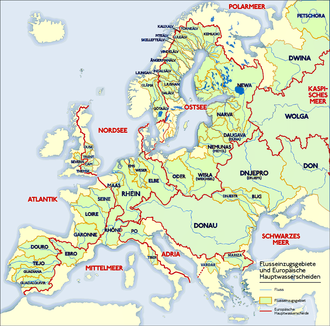European watershed

The main European watershed is the drainage divide ("watershed") which separates the basins of the rivers that empty into the Atlantic Ocean, the North Sea and the Baltic Sea from those that feed the Mediterranean Sea, the Adriatic Sea and the Black Sea. It stretches from the tip of the Iberian Peninsula at Gibraltar in the southwest to the endorheic basin of the Caspian Sea in Russia in the northeast.
Course
Atlantic—Mediterranean

The Watershed runs northwards through
At the
Atlantic—Black Sea



The divide continues northwards along the
Within the Alpine foothills it runs north of the Schussen catchment area of Lake Constance towards the sources of the Brigach and Breg headwaters of the Danube in the Black Forest. It then follows the main ridge of the Swabian and Franconian Jura with the crossing of the Rhine–Main–Danube Canal northeastwards up to the Fichtel Mountains and southeastwards along the Bohemian Forest, forming the border between Germany and the Austrian Mühlviertel and Waldviertel regions with the Czech Republic, where the large Bohemian basin is drained by the Elbe River.[8][9] It again turns northeastwards along the Javořice Highlands to the Králický Sněžník Mountains of the Eastern Sudetes at the border with Poland, where the triple point of the Orlice, Elbe (North Sea); Morava, Danube (Black Sea); and Eastern Neisse, Oder (Baltic Sea) is located at the peak of Klepáč (Trójmorski Wierch). At this point, the European Watershed connects to the North Sea–Baltic Sea Continental Divide.[10]
The Watershed continues in an eastern direction along the
Characteristics
The watershed is not a clearly defined
For example,
See also
61°28′N 37°46′E / 61.467°N 37.767°E
References
- ^ "IDE/Geoportal - CHG". Confederacion Hidrografica del Guadalquivir (Drainage basin for the Guadalquivir river). Retrieved 2021-02-08.
- ^ "Confederación Hidrográfica del Segura". www.chsegura.es (Map of the drainage basin for the Segura River). Retrieved 2021-02-08.
- ^ "Descarga de Datos y Cartografía". Confederacion Hidrografica del Jucar (Map of the drainage basin for the Jucar River). Retrieved 2021-02-08.
- ^ "Sitebro". Confederacion Hidrografica Ebro (Map of the drainage basin for the River Ebro). Retrieved 2021-02-08.
- ^ "Rivers in Spain". www.iberianature.com. Retrieved 12 August 2017.
- ^ "Sandre - Portail national d'accès aux référentiels sur l'eau". www.sandre.eaufrance.fr (Map of the drainage basins in France in the 'Zone Hydrographique' dateset). Archived from the original on 2011-03-07. Retrieved 2021-02-08.
- ^ a b UFAM, Bundesamt für Umwelt BAFU. "Bundesamt für Umwelt - Startseite". www.bafu.admin.ch (Drainage basins in Switzerland in the map 'EZGG.sqlite') (in German). Retrieved 2021-02-08.
- ^ "Umwelt-Daten und -Karten Online". Landesanstalt für Umwelt Baden-Württemberg (Drainage basins in Baden-Würrtemberg in the map 'Basiseinzugsgebiet (AWGN)_polygon.shp'). Retrieved 2021-02-08.
- ^ "Bayerisches Landesamt für Umwelt - LfU Bayern". lfu.bayern.de (Drainage basins in Bavaria in the map 'EZG25_01_2016_by.shp') (in German). Retrieved 2021-02-08.
- ^ "VÚV T.G.Masaryka - Oddělení GIS - O projektu DIBAVOD". Digitální báze vodohospodářských dat (Drainage basins in Czech Republic). Retrieved 2021-02-08.
- ^ "Otwarte Dane" (Drainage basins in Poland in the map 'Wektorowe warstwy tematyczne aPGW').
- ^ "Interactive Database of the World's River Basins - Home". Interactive Database of the World's River Basins (Main drainage basins of the world's rivers). UN Global Compact CEO Water Mandate. Archived from the original on 2021-01-30. Retrieved 2021-02-09.
- ^ H. Hötzl: Origin of the Danube-Aach system. In: Environmental Geology. volume 27, No. 2, 1996, p. 87–96. doi:10.1007/BF01061676
External links
- Interactive topographical map of the European Continental Divide on the site continental-divide.eu
